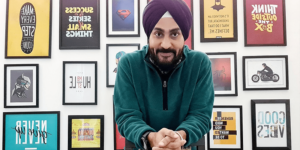When Kavya Singh Kundu wanted to start her own label in the middle of the pandemic, she was prepared for slow growth. However, while working with the weavers, Kavya realised the problem was deeper – they were facing a lot more difficulties.
“I was privileged to be able to start at such a bad time, but for them things were tough and sales were at an all-time low. Most of the weavers made money from a business-to-business working model where they made the fabrics for other designers on order. As designers all over the world have stopped production now, it has affected them the most. They had no direct consumers and no idea of the possibility of having a digital platform for sales,” says Kavya.
This is when Kavya decided to buy their dead stock of jamdani fabric and create a one-of-a-kind, limited upcycled edition as part of her latest venture, Tale as old as Time.
Kavya with Weavers
Kavya also decided to open up this project to consumers who would like to reuse their own old sarees and create something new from them, reiterating the idea of sustainability and reusing what they already own.
“Simultaneously, I started refurbishing my grandparents’ house in Kolkata, which is my studio. Here, I discovered a lot of old sarees, which nudged me in the direction of taking something old and creating something new from it. All these things combined was like a sign telling me to take on this project and help the weavers in any way I could,” says Kavya.
Starting young
Kavya was inclined towards fashion and design right from childhood and knew it was her calling. Born in Kolkata, Kavya grew up with an affinity to fashion and was naturally enamoured by the feeling of looking good and dressing up well, experimenting with fashion, and having her own style statement.
“While my parents were working, I spent a great deal of my childhood with my grandparents, and both my grandmoms enjoyed dressing up and took good care of themselves – never a strand of hair out of place or an outfit without matching jewellery,” says Kavya.
Kavya with a weaver
Entrepreneurial journey
As she grew up, Kavya knew she had to take a formal education in the space. She moved to Delhi to study Fashion Design at the National Institute of Fashion Technology (NIFT). Kavya graduated in 2017 and moved back to Kolkata and worked as a designer for a few brands before starting her own label in 2020.
“I enjoyed a hands-on experience working with artisans and overseas buyers. I travelled internationally and worked on fashion shows and even helped develop a new line for an existing brand. I think all these experiences really moulded me in a way in which I could gather the courage to start my own label,” says Kavya.
Starting up was a part of everyday life as Kavya’s parents run their own independent businesses and always encouraged her to do the same.
“I always got full support from my family and I don’t think they have burdened me with any biases, consciously or unconsciously. However, I have faced a few biases with vendors, who thought I was perhaps too young to be making business decisions.
Sometimes, a few acquaintances saw my work as a tailoring venture and not a brand and assumed that my business is production and not design based. I’ve seen this with a lot of educated and well-travelled people as well, because it’s true this business is a hard one and there are many players in the market, but only a handful make it to the top, whereas a lot of them stall at a “boutique” level. This would infuriate me the most, but now I just tune it out and keep at my work,” says Kavya.
The challenges
Once she started up, the biggest challenge was staying true to the ethos of the brand while being hit by an economic halt. But Kavya made sure her designs were classic and not something based on a six-month-long trend just to get more sales.
“I made sure I stayed true to my clients and asked them to purchase only what they would wear and not indulge in spontaneous buys. I made sure I paid my team well and offered them leave when traveling to work could be a health risk to them and myself,” says Kavya.
Explaining some of the challenges she faced, Kavya says, “There were times when I felt I didn’t fit into a niche, since my aesthetic was very high street, but the price points were that of slow and sustainable fashion. So essentially the demographic that liked the clothes couldn’t afford them and the one who wanted more traditional styles.”
While this is still a challenge, Kavya says she is working on creating collections that cater to all sensibilities while being as affordable as they possibly can.
“There were many other challenges that come with starting a new business and learning how to grow and support communities. I wouldn’t say I’ve learned how to overcome these challenges. I face a new one every day…but at least these challenges are proof that I’m constantly learning new things and that they will all help in ways more than one,” adds Kavya.
Understanding the weaves
Since she wanted to focus on jamdani, Kavya looked primarily for deadstock with hints of the craft. Selling jamdani for the weavers is difficult than a regular fabric woven by them as it’s more expensive, and since they don’t have a direct consumer market, they don’t know how and whom to sell those to.
“I would visit the weavers in Phulia and look at the dead stock and I would make small selections of similar colour stories, motif groups, and other combination fabrics that could tie the whole collection together. I would then decide a few patterns that I wanted to play around with, keeping the nature of the fabric and season in mind,” says Kavya.
Once the test fits for the patterns were ready, Kavya would sit with her team and decide which fabric would be best for which pattern.
“Most often, the fabric itself dictates the nature of the garment and I always try to go with the flow rather than force an idea I may have had about that particular style. The entire process is a very hands-on one where we sit and discuss together,” says Kavya.
Sometimes, the team also tries to work backward where they think of an occasion for the garment and a price point based on the look and feel, and design a garment around it to fit that description. Kavya feels it also helps the team to work together better, and in turn makes for an enthusiastic, spirited working environment.
She says, “My advice to first-time entrepreneurs is to be passionate about what you do and what you love and put your all into it, go the extra mile, and make many mistakes. But know when to take a step back and objectively analyse yourself and your growth, and if something is not working then know when to drop that and start again.”
She adds, “There is no formula to get it right always. In fact, the more you get it wrong, the bigger and better it will be in the future. Other than that, have fun and enjoy, talk to as many people as you can about anything and everything because no knowledge is wasted or unimportant so keep your eyes wide open and enjoy the ride.”

![You are currently viewing [100 Emerging Women Leaders] How fashion designer Kavya Singh Kundu is helping Jamdani weavers upcycle their dead stock during the pandemic](https://blog.digitalsevaa.com/wp-content/uploads/2021/05/Imagez8cq-1621519935269.jpg)








